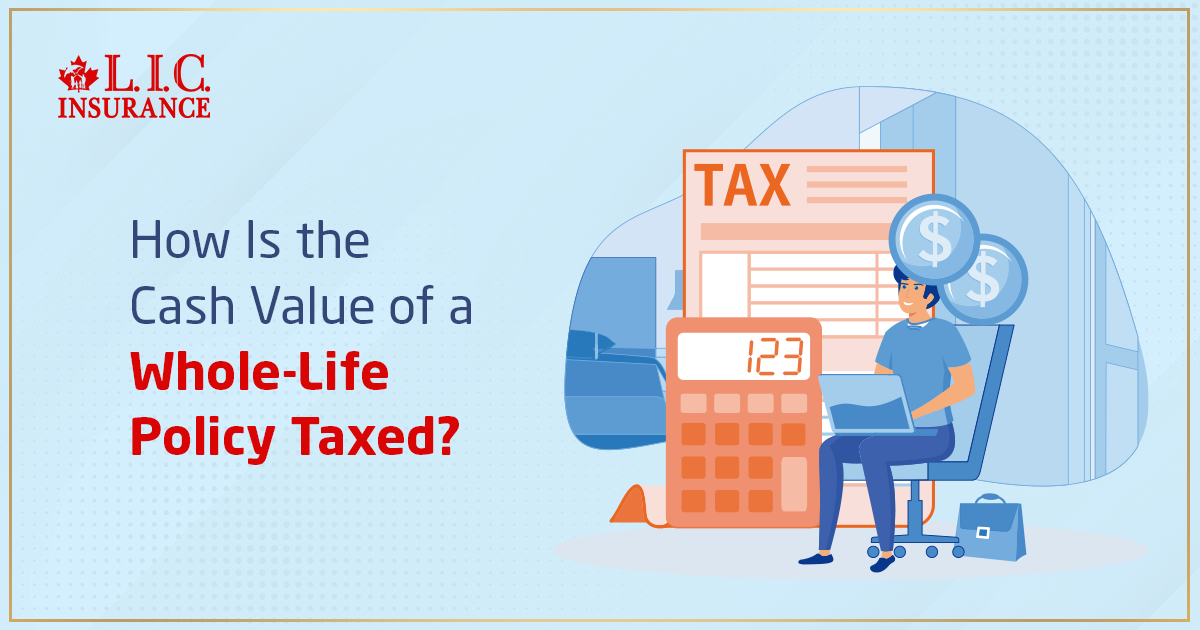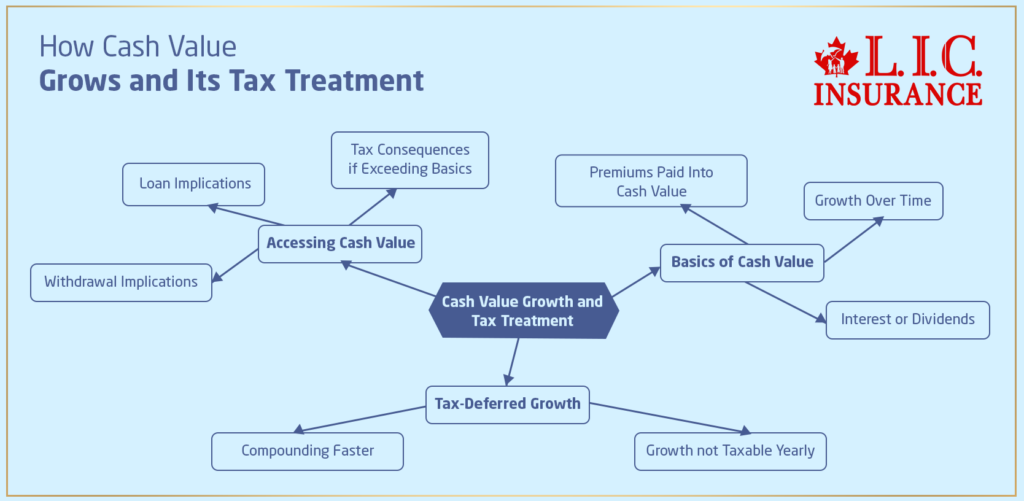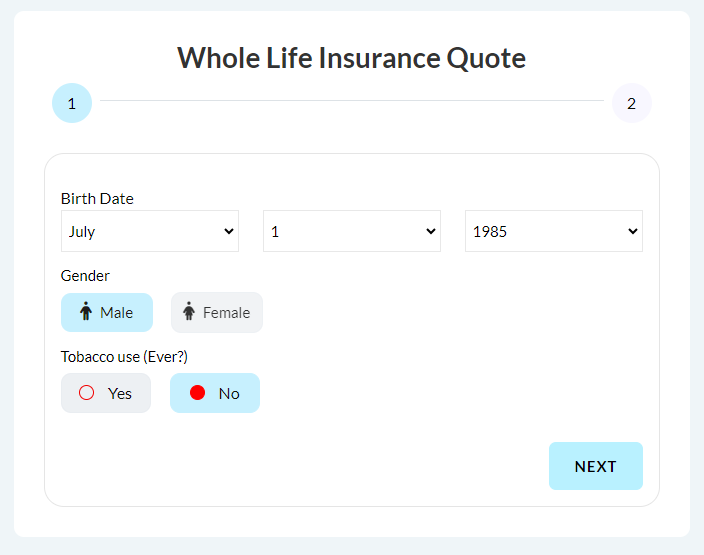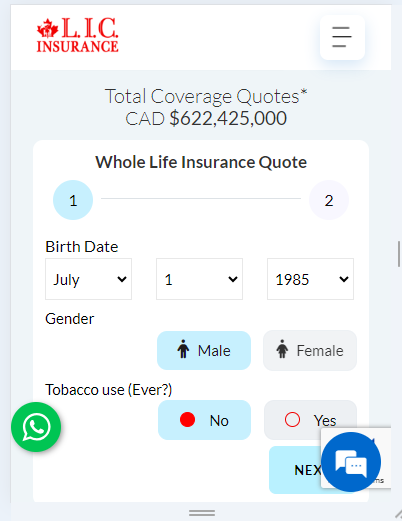
Do you ever get curious about the taxability of the cash value of your Whole Life Insurance Policy? Let’s take a closer look at a scenario that might sound familiar. Imagine you are reviewing your monthly bills and expenses, trying to optimize where your money goes each month. That monthly cost of your Whole Life Insurance is certainly one of those expenses. It’s a steady figure, predictable, but you remind yourself that your policy is two things: a death benefit as well as a cash value. The next thing that will come to your mind is, “What about the taxes on this percentage?” I worked hard for my money. Have I gotten the most out of it? It can be hard to understand how life insurance works, especially if you’re trying to plan for your financial future since the cash value in a whole life coverage will affect your money. There are important tax rules in Canada that affect the cash value of your policy. This is true whether you are looking to buy a policy and comparing Whole Life Insurance Quotes or you already have a policy and are thinking about how good it is when you want to have its cash value in the long run. The goal of this blog is to help you understand some of those complicated rules by telling you stories that you can relate to. The goal of this blog is to help you understand some of those complicated rules by telling you stories that you can relate to. So let’s start.
How Cash Value Grows and Its Tax Treatment

The Basics of Cash Value
In general, as you pay premiums on a Whole Life Insurance Policy, a fraction of every payment is going into your cash value. This part increases over time, either by a flat interest rate agreed upon by the insurance company or by dividends, depending on the terms of your policy. What you are seeing regarding this growth is not mere statistics, but actual money that can be there for you in your lifetime.
Tax-Deferred Growth: A Real-Life Situation
Samaira, a graphic designer, purchased her whole life policy ten years ago. As she climbed up the ranks in her career over the years, she earned more money in a higher tax bracket. Yet the increase in her policy’s cash value was considered a form of tax deferral, so it did not increase her taxable income each year. That meant the money she had in the cash value of her policy could sit and grow tax-deferred for years, compounding faster than an equally sized taxable investment might.
When you take cash from the cash value — by either a withdrawal or a loan — there are tax implications. It is tempting to just take your cash value, but realize that if you take withdrawals above your policy’s basis (premiums paid), there may be a tax bill.
Accessing Cash Value: Tax Implications
When you decide to access the cash value—be it through withdrawal or a loan—there are different tax consequences. Withdrawing your cash value might seem like a straightforward option, but it’s essential to understand the potential tax hit if withdrawals exceed your policy’s basis, the amount of total premiums you have paid.
Example of Withdrawal Impact
Let’s take the case of Mike, a small business owner. When he needed to fund his business’s expansion, he considered withdrawing from the cash value of his insurance. However, upon consulting his financial advisor, he learned that withdrawing an amount beyond what he had paid in premiums would be taxable. This realization made him rethink his strategy to avoid an unexpected tax bill.
Whole Life Insurance Cost and Tax Strategies
Structuring Your Policy for Tax Efficiency
An essential part of privacy to manage Whole Life Insurance Costs is understanding how to structure your policy to maximize tax efficiency. This is important for anyone with high Whole Life Insurance premiums wishing to lessen the financial burden.
Real-Life Strategy Implementation
Imagine a couple, John and Linda, who are in their mid-50s. They’ve been paying into their whole life policies for nearly three decades. Their financial advisor recommended they borrow against the cash value to pay the premiums, lowering their monthly out-of-pocket expense but keeping the policy intact. This move not only helps in managing their expenses better but also keeps the policy’s benefits intact without increasing their taxable income.
Considering Whole Life Insurance Quotes
While you might think comparison shopping when it comes to a Whole Life Insurance Policy refers solely to getting quotes, it is about more than just dollar numbers. It is more about dissecting the numbers and more importantly how the underlying tale or the tax treatment of the cash value in the policy.
A Tale of Comparing Quotes
Elena, a teacher, spent weeks comparing different Whole Life Insurance Quotes, trying to find the best value for her investment. She looked specifically at how different policies handled the accumulation and taxation of cash value, eventually choosing a policy that offered a favourable balance between growth potential and tax advantages.
Concluding Thoughts
Appreciating the tax treatment of the cash value in Whole Life Insurance Policies in Canada can make a huge difference in how you approach your financial planning. Even in the stories we’ve seen, from Smaira’s tax-deferred benefits to Michael’s thoughts on the tax implications of transfers, it’s important to understand these kinds of things so that when they happen, you know what’s going on and can make smart decisions about your future. You can make the same kinds of changes to your cash problem or goal right now. One of the top insurance brokerages, Canadian LIC, is here to support you with Whole Life Insurance Policies. They can help you craft a policy that will not only suit your insurance needs but also so that it can be in a tax-efficient manner that helps the overall state of your long-term finances. Confusion about taxes should not prevent you from ensuring a financially sound life ahead. Contact Canadian LIC today to ensure that you begin your journey towards a more financially secure future by purchasing a Whole Life Insurance Policy that is best suited for you.
Find Out: How to find the best Whole Life Policy without a medical exam?
Find Out: What age does Whole Life Insurance end?
Find Out: The 2 Disadvantages of Whole Life Insurance
Find Out: How many years does one have to pay on Whole Life Insurance?
Find Out: The difference between Whole Life Insurance and Term Life Insurance
Find Out: Can Whole Life Insurance be bought for a child?
Find Out: Who should go for Whole Life Insurance?
Find Out: Is Whole Life Insurance costly?
Find Out: Everything about Whole Life Insurance
Find Out: Whole Life Insurance Benefits
Get The Best Insurance Quote From Canadian L.I.C
Call 1 844-542-4678 to speak to our advisors.

FAQs on Taxation of Cash Value in Whole Lif?e Insurance Policies
Great question! With a Whole Life Insurance Policy, pulling out your cash value does not immediately reduce the cost of your policy across the board. But, let’s take the case of Raj in trying to borrow against his policy cash value to cover his daughter’s wedding. While borrowing against the cash value did not affect his monthly cost for the Whole Life Insurance Policy, it meant that the loan amount was set to charge him interest. If Raj doesn’t pay back the loan, the loan amount plus interest may be subtracted from the policy’s death benefit, which will, in turn, affect the value of the policy to his beneficiaries.
Absolutely, this is a way to save money on taxes! The additional cost per month is generally your contribution to the cash value component of your policy and is growing tax-deferred. It was for Patricia, a consultant, who selected a slightly higher premium option in order to grow her cash value faster. This enables her to not only have a higher fund with her in the future but also allows her to stop paying taxes on the growth of these funds, optimizing her tax-deferred account.
Comparing Whole Life Insurance Quotes becomes important in order to know the tax aspect of your cash value with different policies. A self-employed man named Alex, for example, pored over several quotes and concentrated on how much the cash value would appreciate and be taxed. What he found was that with some policies, there was the ability to allow for accelerating the growth of the initial cash value, and some with different tax consequences. Comparing those rates allowed Alex to find a policy that not only fit his budget but provided a model tax treatment best suited to his financial objectives.
Answer: When you begin to draw on the cash value, any withdrawals or loans against your policy could have a taxable and also taxable nature. Let’s look at Mei’s scenario. Mei, a real estate agent, planned on using some of her cash value toward purchasing a property. She decided to use a loan against her policy to defer taxes and keep her policy intact. This strategy allowed her to invest without facing the tax consequences that would come with withdrawing the funds outright.
The tax treatment of the cash value in your policy can make a big difference in terms of its entire value over time. If Sam and his wife Nora had both bought Whole Life Insurance Policies at the same age, then they both would have paid the same premiums and received the same death benefit. Sam elected a policy with a higher cash value accumulation rate that grew tax-deferred, so his cash value ended up growing much faster than Nora’s, who selected a lower fee policy but with slower growth of cash value. Sam’s policy over the years not only acted as a large safety net for both of them but grew beautifully being heavily invested in his policy — causing the total value of their financial assets to increase economically with an attractive tax treatment.
Yes, the cost of your Whole Life Insurance Policy has some bearing on future tax liabilities, especially if you surrender the policy or make withdrawals from the cash value. Take Oliver, for example, who decides to surrender his entire life policy after several years to gain some cash right now. Since the cash value was greater than the premiums he had paid, this surrender triggered a taxable event. Maybe he would have planned his money differently if he’d known about the taxes he would owe.
Reducing your monthly expenditure by looking for cost-effective options is a good idea. Anita, a software developer, is an apt example who found it challenging to make her premium payments initially. Talking it over with her insurance agent, Anita found that she could either change the face value of her policy or change to a different payment schedule so that her premium could be paid out over a longer term and therefore be more affordable. That being said, make sure that changing your policy would not impact the benefits that you do receive and is something that you discuss with a professional before making a switch.
Whole Life Insurance – Your initial premium cost for your Whole Life Insurance Policy can be very different for a 20-year-old in perfect health, and an overweight 50-year-old concerned about covering final expenses. Take, for example, Javier, a thirty-something gym instructor who inquired about a Whole Life Insurance plan. Javier, who was very healthy and did not smoke, did qualify at good rates. To find the most affordable Whole Life Insurance Policy rates based on your health, you will need to compare Whole Life Insurance Quotes from several Whole Life Insurance companies.
Yes, it can. Gender has been among the factors insurance companies use to calculate premiums and is based on life expectancy statistics. For example, married couple Lisa and Mark experienced that while Lisa’s premium was only slightly lower than Mark’s, even though they were the same age and in almost the same health. The latter is often due to the fact that women statistically live longer than men and so their risk profile can be reduced.
Whole Life is a versatile product and its cash value use adds a big asset for estate planning. George, who has since retired, took advantage of his policy’s cash value to pass on an inheritance to his grandchildren as he lived. He had borrowed against the cash value to send his grandchildren to school while the death benefit would pay off the loan and still leave a legacy.
Yes, it is absolutely possible to get a Whole Life Insurance quote online, and it can be very convenient and effective. Online methods arrived to Emily – a sales and marketing consultant who is too in demand to sort out – to help her get estimates. This enabled her to compare interest rates swiftly and avoid the hassle of having to meet up physically with agents. Quotes are often more generalized when you receive them online, and there are bespoke factors about you and your belongings that should be addressed with an agent to provide more accurate price quoting.
Stopping your premium payments can lead to a policy lapse, where coverage is cancelled. An entrepreneur, Tom, ran into financial troubles and stopped making payments. The cash value in his insurance policy allowed his policy to remain in force for a couple of months so that he could get his finances in order before the policy lapsed. If you expect that you will have trouble making payments in the future, it is important for you to reach out to your insurer about options such as premium holidays or loans against the cash value.
Dividends are an important selling point for Whole Life Insurance. If you receive dividends, they can significantly reduce your costs. For example, Sandra owns a participating Whole Life Insurance Policy. Every year, her insurance company pays her dividends from the general surplus, and she applies the refunds toward her premiums, lowering, in essence, her annual direct out-of-pocket expense. Dividends aren’t guaranteed, but there are plenty of companies out there with long histories of paying them.
Knowing some of these FAQs will help you go through the complexities of Whole Life Insurance and allow you to execute decisions that are in line with your financial and tax planning goals. Each choice is crucial and can go a long way in affecting the strength of your policy and subsequently your wallet.
Sources and Further Reading
Canada Revenue Agency (CRA) – Official site for tax regulations and guidelines specific to insurance products in Canada. Visit CRA
Insurance Bureau of Canada – Provides detailed information on various types of insurance, including whole life policies available in Canada. Visit Insurance Bureau of Canada
Financial Consumer Agency of Canada – Offers comprehensive guides on life insurance products, helping consumers understand the nuances of insurance policies. Visit FCAC
Investopedia – Useful for explanations on financial terms and concepts, particularly regarding the taxation of life insurance policies. Visit Investopedia
Life Insurance Canada – Provides resources and articles on different aspects of life insurance, including cost comparisons and what to expect from whole life insurance. Visit Life Insurance Canada
These resources will provide you with further insights into whole life insurance, its costs, taxation, and how to effectively manage your policy in Canada.
Key Takeaways
- The cash value in whole life insurance grows tax-deferred, allowing effective compounding over time.
- Understanding when taxes apply to your policy's cash value can guide financial decisions.
- Factors like age and health influence whole life insurance costs; comparing quotes is essential.
- Use the cash value strategically for financial needs such as loans, retirement funds, or premium payments.
- Consulting financial professionals and tax advisors ensures your policy aligns with financial goals and tax situations.
Your Feedback Is Very Important To Us
The above information is only meant to be informative. It comes from Canadian LIC’s own opinions, which can change at any time. This material is not meant to be financial or legal advice, and it should not be interpreted as such. If someone decides to act on the information on this page, Canadian LIC is not responsible for what happens. Every attempt is made to provide accurate and up-to-date information on Canadian LIC. Some of the terms, conditions, limitations, exclusions, termination, and other parts of the policies mentioned above may not be included, which may be important to the policy choice. For full details, please refer to the actual policy documents. If there is any disagreement, the language in the actual policy documents will be used. All rights reserved.
Please let us know if there is anything that should be updated, removed, or corrected from this article. Send an email to [email protected] or [email protected]



